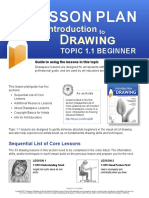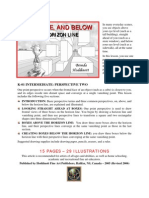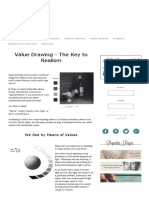Drawing Exercise Memory
Drawing Exercise Memory
Uploaded by
Anonymous 4oVLhGRCopyright:
Available Formats
Drawing Exercise Memory
Drawing Exercise Memory
Uploaded by
Anonymous 4oVLhGROriginal Title
Copyright
Available Formats
Share this document
Did you find this document useful?
Is this content inappropriate?
Copyright:
Available Formats
Drawing Exercise Memory
Drawing Exercise Memory
Uploaded by
Anonymous 4oVLhGRCopyright:
Available Formats
Flesch-Kincaid Grade Level: 11.
0
Flesch-Kincaid Reading Ease: 46.5
Drawspace Curriculum 2.2.R15 - 6 Pages and 8 Illustrations
Drawing on
Your Memory
Techniques for seeing and remembering potential
subjects so you can translate your
memories into drawings
This tutorial has three sections:
Seeing to Remember
ArtSpeak
Storing an Image in Memory
Translating Memories into Drawings
You add a whole new dimension to your artistic
skills when you can draw from your memory.
Think about the pleasures of being able to
draw anywhere and anytime, knowing that your
drawing subject is safely tucked away inside
your mind.
Seeing to Remember
If you watch television or movies, you have
probably seen a sketch artists drawing of a
criminal suspect.
A sketch artist (also called a forensic artist)
translates the memories of eyewitnesses and
victims into drawings. Memory enhancement
techniques are integral to accessing the
information required to create drawings based on
someone elses memory.
Forensic art: Artistic techniques
used by police departments and
investigative agencies in the
identification, apprehension, and/
or conviction of wanted or missing
persons.
Perception: The manner in which
you understand, and process sensory
information.
Cognitive interview: A forensic
interviewing technique that uses
visualization strategies to enable
eyewitnesses and victims to
accurately remember surroundings,
people, and/or information about a
crime.
Visualization: The formation of a
visual image in the mind.
Air-drawing: A memory enhancement
technique for remembering images.
A pen, pencil, finger, or your vision
is used to follow the contours of a
potential drawing subject while you
mentally describe every detail with
words.
ISBN: 978-1-927539-43-9
Copyright 2013 Drawspace Publishing and Brenda Hoddinott. All rights reserved. No part of this publication may be reproduced, stored in a retrieval system, transferred, or transmitted in any form or by any means, including
electronic, digital, mechanical, recording, photographing, photocopying, or otherwise, without the purchase of a licence from drawspace.com or the prior written consent of Brenda Hoddinott and Drawspace Publishing.
Drawspace Curriculum 2.2.R15
As an Aside
During my 25-year career (1978-2003) as a forensic
artist, I was often asked, How do you draw from
someone elses memory? Simple answer: Its not
much different than drawing from your own memory.
Visualization techniques facilitate the gathering
of credible information by attempting to bring
all five senses into the memory enhancement
process. Throughout this initial visualization stage
of a cognitive interview, I would write meticulously
detailed notes. Then, I continuously referred to these
notes while the victim or eyewitness helped me
create a composite drawing.
Surprisingly, these same techniques
also help artists learn how to
remember potential drawing
subjects. Your five senses (seeing,
hearing, smelling, touching, and
tasting) feed sensory information to
your memory.
Seeing employs both vision and
perception to trigger strong sensory
memories. You need to accurately
see a potential subject before you
can attempt to draw it from memory.
Factors such as time, viewpoint,
distance, and clarity influence your
memory of what you see.
Time
As an Aside
A study published in Applied Cognitive Psychology
on drawing and memory revealed that participants
who doodled while they listened to recorded names
of people and places remembered 29% more of
what they heard than those who werent doodling.
Taking time to carefully observe your
subject is integral to remembering
visual information. If youre texting
a friend while running to catch
the subway, you probably wont
remember much about a clown
sitting on the steps of the art gallery.
However, if youre walking
and paying attention to your
surroundings, you may see the
clown and possibly store enough
information in your memory to later
draw her.
Figure 1
Viewpoint
You can retain more information
about anything you want to
remember when you view it from
all sides. Examine a frontal view
of a suspect (oops - meant to say
subject) in Figure 1.
Check out another mugshot of the
same subject in profile (Figure 2).
From this viewpoint, the shape of the
head is somewhat unexpected.
ISBN: 978-1-927539-43-9
Copyright 2013 Drawspace Publishing and Brenda Hoddinott. All rights reserved. No part of this publication may be reproduced, stored in a retrieval system, transferred, or transmitted in any form or by any means, including
electronic, digital, mechanical, recording, photographing, photocopying, or otherwise, without the purchase of a licence from drawspace.com or the prior written consent of Brenda Hoddinott and Drawspace Publishing.
Drawspace Curriculum 2.2.R15
Try to imagine what this criminal
mastermind looks like from
behind.
Figure 2
Distance
When a subject is far away, you
cant see it very well. On the
other hand, if you are too close,
you may not be able to see its
entire shape and form.
Ideally, you need to examine a
subject from both far away and
close-up.
In Figure 3, Wesley the Maltese
is too far away to see much in
the way of details.
Figure 4
Figure 3
Youre more likely to see and
remember enough information to
sketch his face and body if hes a little
closer (Figure 4).
ISBN: 978-1-927539-43-9
Copyright 2013 Drawspace Publishing and Brenda Hoddinott. All rights reserved. No part of this publication may be reproduced, stored in a retrieval system, transferred, or transmitted in any form or by any means, including
electronic, digital, mechanical, recording, photographing, photocopying, or otherwise, without the purchase of a licence from drawspace.com or the prior written consent of Brenda Hoddinott and Drawspace Publishing.
Drawspace Curriculum 2.2.R15
If Wesley jumped into your lap and began licking your nose, you may remember feeling the
wispy hairs of his mustache on your face and seeing the shine in his eyes. However, if this
was the only time you saw him, you may have no memory of his head or body.
Figure 5 demonstrates what you need to see and remember to draw his adorable face.
Figure 5
As an Aside
As a forensic artist, I was
once called to a bank that
had been robbed by a male
suspect without a mask. I
created sketches with each of
the three witnesses who had
clearly seen him close-up.
When the detectives and I
later met up, we compared the
three drawings.
The three men looked very
different from one another
they didnt even look like
cousins.
Yet, each witness had clearly
remembered and described
in great detail the brightlycolored, cartoon Band-Aid
across his nose.
Clarity
Challenge!
Find a familiar object. Look
at it from three different
distances:
the other side of the room
the middle of the room
very close to your face.
Note how much detail you can
see from each distance.
Lighting conditions, weather, and air pollutants affect
how well or how poorly you see a potential subject.
Early morning or late evening may not provide enough
light to see an outdoor subject clearly. In addition, if
a strong light source such as a sunrise or sunset is
behind a subject, you may see only its silhouette rather
than details (Figure 6).
Subjects may appear blurry on a foggy, snowy, or rainy
day (Figure 7).
Under ideal lighting conditions, you may be able to
remember enough information to create a sketch
(Figure 8).
ISBN: 978-1-927539-43-9
Copyright 2013 Drawspace Publishing and Brenda Hoddinott. All rights reserved. No part of this publication may be reproduced, stored in a retrieval system, transferred, or transmitted in any form or by any means, including
electronic, digital, mechanical, recording, photographing, photocopying, or otherwise, without the purchase of a licence from drawspace.com or the prior written consent of Brenda Hoddinott and Drawspace Publishing.
Drawspace Curriculum 2.2.R15
Figure 6
Figure 7
Figure 8
Storing an Image in Memory
Several people can view the exact same subject under identical conditions, and yet each
person may remember a completely different image. A perceived visual image of a subject
may not be the same as how that subject looks in reality. For instance, if you believe that
the branches of all trees are straight, then when you retrieve a memory of a specific tree,
you may draw it with straight branches.
Even when you see a subject correctly, your brain may record images based on your
current state of mind as well as memories of and experiences with similar subjects.
Forensic artists often refer to these phenomenons of perception as memory pollution.
Images that you see can be remembered both verbally and visually. A strong visual image
can be translated into a narrative and vice versa. For example, a verbal description of a
suspect, based on an eyewitnesss visual memory, is provided to a forensic artist, who then
translates that verbal description back into an imagea sketch of the suspect.
Translating Memories
into Drawings
Tip!
Your mind records everything you see in much the
same way as a video recorder. Trying to retrieve
these memories and translate them into drawings is
often a challenge. A technique called visualization is
used by both forensic artists and forensic hypnotists
to help individuals remember valuable information
about a crime scene and/or a suspect.
Try air drawing a potential drawing
subject to remember visual
information. Simply follow the
contours of a subject with your
eyes (or a finger) while mentally
describing every detail with words.
You then have both a visual and
verbal memory.
ISBN: 978-1-927539-43-9
Copyright 2013 Drawspace Publishing and Brenda Hoddinott. All rights reserved. No part of this publication may be reproduced, stored in a retrieval system, transferred, or transmitted in any form or by any means, including
electronic, digital, mechanical, recording, photographing, photocopying, or otherwise, without the purchase of a licence from drawspace.com or the prior written consent of Brenda Hoddinott and Drawspace Publishing.
Drawspace Curriculum 2.2.R15
These steps can help you use visualization to
draw from your memory:
1. Sit comfortably in a quiet place with no
distractions. Relax your body and mind,
and close your eyes.
2. Warm up your brain by first trying to
visualize a blue sky with clouds or a
simple object.
3. Try to remember where you were and
what you were doing before you saw the
subject. Think about your surroundings
what the weather was like outside, if
you could hear any sounds, or if there
were any memorable smells. Pretend
your mind is a video recorder and play
back these few minutes.
Tip!
You can sometimes find forgotten
information by doing a little research.
Imagine, for instance, that youre
walking through a park when you spot
the most adorable Maltese ever. You
store tons of information into memory so
you can draw her when you get home.
At home, you begin to draw and
quickly realize that you are missing
some important details. Time for a little
detective work! Each dog of this breed
looks slightly different, but the basic
characteristics and anatomy are very
similar. By researching Maltese dogs
online or in books, you can draw the one
you saw more accurately.
4. When you reach the point in your
memory where you see the object,
pretend to press the pause button and
freeze the mental image.
5. With your eyes still closed, mentally
trace the outline and details of the object
in your mind.
Your memory of an experience is strongest
immediately after the experience has occurred.
Within minutes, you begin to forget some
information, so its important to render a
rough sketch of a potential subject as soon
as possible. If you wait more than 24 hours,
the image becomes increasingly difficult to
remember.
Getting past the influences of perception and
accurately remembering what you see takes
lots of time and practice. Making sketches from
real life every day adds a wealth of accurate
visual information to your memory. As you
become more knowledgeable about various
subjects, you get better at drawing images
from your memory. When you can draw on
your memory, you are ready to try your hand at
creating new and exciting drawings from your
imagination.
As an Aside
As an expert in artistic facial anatomy,
I am aware of the generic rules of adult
facial proportions.
A few years ago, I worked with a
witness for several hours and ended
up with a sketch of the ugliest man I
had ever seen. The placement of his
facial features based on the witnesss
description broke every single rule of
facial proportions.
I figured this was one suspect who
would never be caught.
A few weeks later, I was at that same
police station when an excited detective
approached me to say, We caught the
guy in the sketch you did last month!
Would you like to see his mug shot?
Well, I was totally shocked by the
photohe looked exactly like my
drawing. Needless to say, I was thrilled
(and relieved) that I hadnt allowed
my knowledge of facial proportions to
influence the drawing.
ISBN: 978-1-927539-43-9
Copyright 2013 Drawspace Publishing and Brenda Hoddinott. All rights reserved. No part of this publication may be reproduced, stored in a retrieval system, transferred, or transmitted in any form or by any means, including
electronic, digital, mechanical, recording, photographing, photocopying, or otherwise, without the purchase of a licence from drawspace.com or the prior written consent of Brenda Hoddinott and Drawspace Publishing.
You might also like
- Cross Contour DrawingDocument2 pagesCross Contour DrawingScheed Cole67% (3)
- The Perspective Drawing Guide: Simple Techniques for Mastering Every AngleFrom EverandThe Perspective Drawing Guide: Simple Techniques for Mastering Every AngleRating: 4 out of 5 stars4/5 (1)
- Art of Drawing Clothing On Figures How To Draw Folds Fabrics and DraperyDocument3 pagesArt of Drawing Clothing On Figures How To Draw Folds Fabrics and DraperyAdhkar wa akwalNo ratings yet
- Contour Drawing Guided NotesDocument1 pageContour Drawing Guided Notesapi-373754262No ratings yet
- Three Qualities To Take The Paralysis Out of Decision AnalysisDocument6 pagesThree Qualities To Take The Paralysis Out of Decision AnalysisAnkita BhuniyaNo ratings yet
- Guide To Drawing by Bill MartinDocument91 pagesGuide To Drawing by Bill MartinGlenn Dano100% (1)
- Perspective GridsDocument8 pagesPerspective GridsAdithyan GowthamNo ratings yet
- Perspective Hand DrawingDocument37 pagesPerspective Hand DrawingLadunca Mihai90% (21)
- Perspective Drawing GuideDocument24 pagesPerspective Drawing GuideScheed Cole90% (10)
- Composition Artists CourseDocument18 pagesComposition Artists CourseYoni Salmon100% (2)
- Interactive Reading ModelDocument27 pagesInteractive Reading ModelLau Kai Ying0% (1)
- © Pearson 2017: Instructions For Submitting Forms For Asha CeusDocument9 pages© Pearson 2017: Instructions For Submitting Forms For Asha CeusgilbertoNo ratings yet
- Draw What You See Not What You Think You See: Learn How to Draw for BeginnersFrom EverandDraw What You See Not What You Think You See: Learn How to Draw for BeginnersNo ratings yet
- Drawspace-2 1 R01Document7 pagesDrawspace-2 1 R01Artur da Gloria100% (1)
- Drawspace ADocument62 pagesDrawspace Agogu69_1100% (1)
- Drawspace-1 1 R01Document7 pagesDrawspace-1 1 R01Artur da Gloria100% (1)
- Redendering TechniquesDocument25 pagesRedendering TechniquesMitchell Obiora100% (1)
- 8 FD - Week 1 - Adonis CaraDocument15 pages8 FD - Week 1 - Adonis CaraRamlede Benosa100% (1)
- Blind Contour DrawingsDocument17 pagesBlind Contour Drawingsapi-234933583100% (2)
- Perspective Theory PDFDocument14 pagesPerspective Theory PDFCassio Marques100% (1)
- On - Above, and Below The Horizon LineDocument15 pagesOn - Above, and Below The Horizon LinekabadahijaNo ratings yet
- Tips To Improve Your Realistic DrawingDocument4 pagesTips To Improve Your Realistic DrawingColeen gaboyNo ratings yet
- Drawing Step by StepDocument24 pagesDrawing Step by StepScribdTranslationsNo ratings yet
- Figure DrawingDocument3 pagesFigure DrawingKrishna DhyaniNo ratings yet
- Andrew LoomisDocument2 pagesAndrew LoomisMeghan LangNo ratings yet
- The Basics of Ink Techniques - Hatching and Cross-Hatching - Eugenia HaussDocument9 pagesThe Basics of Ink Techniques - Hatching and Cross-Hatching - Eugenia HaussAliaa Ahmed ShemariNo ratings yet
- Drawing Practice For BeginnersDocument11 pagesDrawing Practice For BeginnersAhmaddraws100% (1)
- Freehand DrawingDocument5 pagesFreehand DrawingAmy ApiladoNo ratings yet
- Draw SpaceDocument8 pagesDraw SpaceAlejandro LimaNo ratings yet
- Aerial PerspectiveDocument4 pagesAerial PerspectivegalegatorNo ratings yet
- Setting Up A Creative Space: Choosing A Comfortable Chair and Drawing SurfaceDocument3 pagesSetting Up A Creative Space: Choosing A Comfortable Chair and Drawing SurfaceTabita IonescuNo ratings yet
- Draw Better SampleDocument26 pagesDraw Better SampleSimona DumitruNo ratings yet
- Working With The Human Form Contour DrawingDocument7 pagesWorking With The Human Form Contour Drawingnrjmn firmanNo ratings yet
- Drawing Architecture: An Interview With David MacaulayDocument4 pagesDrawing Architecture: An Interview With David MacaulayminoasNo ratings yet
- A Free Guide To Pencil Shading Techniques For Beginning Artists Author Drawing FundamentalsDocument34 pagesA Free Guide To Pencil Shading Techniques For Beginning Artists Author Drawing FundamentalsminhtriNo ratings yet
- Art 10 - Wire Self-PotraitsDocument12 pagesArt 10 - Wire Self-Potraitsapi-535552931No ratings yet
- 1-Point Perspective DrawingDocument17 pages1-Point Perspective DrawingHiranmai Ganisetti100% (1)
- 03 Ws Action AnalysisDocument8 pages03 Ws Action AnalysisAnkit ChawlaNo ratings yet
- Shading TechniquesDocument7 pagesShading TechniquesMelissa Wilson100% (1)
- Three-Quater Face Schematics PDFDocument20 pagesThree-Quater Face Schematics PDFSchiteanu Claudiu100% (1)
- Basic: Brenda HoddinottDocument7 pagesBasic: Brenda HoddinottDaniela Alexandra DimacheNo ratings yet
- List of Art EbooksDocument4 pagesList of Art EbooksSheilaMaeBernaldez67% (3)
- Brenda Hoddinott: B-04 Beginner: Learn To SeeDocument12 pagesBrenda Hoddinott: B-04 Beginner: Learn To Seeaniko11No ratings yet
- 2 Point Perspective How To: Learn The Basics of Two Point Perspective With These BoxesDocument21 pages2 Point Perspective How To: Learn The Basics of Two Point Perspective With These BoxesAmaka NicholasNo ratings yet
- The Complete Book of Drawing TechniquesDocument2 pagesThe Complete Book of Drawing TechniquesShubham imts100% (1)
- Beverly Hills Intensive English Centre Drawing Work SheetDocument23 pagesBeverly Hills Intensive English Centre Drawing Work SheetNeoSagaNo ratings yet
- Lesson 1Document103 pagesLesson 1Courtney 'Jackworld' JackNo ratings yet
- Observational DrawingDocument16 pagesObservational Drawingapi-279660401No ratings yet
- Drawing Hands PDFDocument12 pagesDrawing Hands PDFqsplaceNo ratings yet
- Observational DrawingDocument43 pagesObservational DrawingShan Paramesvaran100% (3)
- Making Better Lines, Making Lines BetterDocument15 pagesMaking Better Lines, Making Lines BetterEmanuele SangregorioNo ratings yet
- Tips For How To Draw Better InstantlyDocument5 pagesTips For How To Draw Better InstantlySalimar MacapunoNo ratings yet
- Presentation and Perspective DrawingDocument26 pagesPresentation and Perspective DrawingPXQ DIGITALSNo ratings yet
- Nature Drawing - To Study Form and Structure and Various Shapes Basic FormsDocument32 pagesNature Drawing - To Study Form and Structure and Various Shapes Basic FormsJabbar AljanabyNo ratings yet
- U05 - Leg and FootDocument7 pagesU05 - Leg and FootNgoc ToanNo ratings yet
- Perspective Drawing DemoDocument33 pagesPerspective Drawing DemoJOHN ALFRED MANANGGIT100% (2)
- Perspective EbookDocument179 pagesPerspective EbookAlex Fidel Sandoval100% (8)
- Perspective DrawingDocument35 pagesPerspective DrawingHelen Asuncion75% (4)
- Design SketchingDocument88 pagesDesign SketchingLê NgọcNo ratings yet
- Value Drawing - The Key To Realism: We See by Means of ValuesDocument6 pagesValue Drawing - The Key To Realism: We See by Means of Valuesspuzzar100% (1)
- Pencil Portraits - Drawing The EyeDocument21 pagesPencil Portraits - Drawing The EyeFuad100% (1)
- Drawing Perspective Methods For ArtistsDocument158 pagesDrawing Perspective Methods For ArtistsAnderson100% (2)
- Physiological Response To Fear in Expected and Unexpected Situations On Heart Rate, Respiration Rate and Horizontal Eye MovementsDocument3 pagesPhysiological Response To Fear in Expected and Unexpected Situations On Heart Rate, Respiration Rate and Horizontal Eye MovementsCram Werdna GayucabNo ratings yet
- Mind, Brain, and Education: An Emerging Transdisciplinary Field of Learning and DevelopmentDocument3 pagesMind, Brain, and Education: An Emerging Transdisciplinary Field of Learning and DevelopmentencarnaNo ratings yet
- Chapter 8 Sensation and PerceptionDocument66 pagesChapter 8 Sensation and Perceptionapi-726122866No ratings yet
- EmotionsDocument12 pagesEmotionsIonela CazacuNo ratings yet
- Metalinguistic Knowledge and Language PR PDFDocument11 pagesMetalinguistic Knowledge and Language PR PDFZăvadă TedNo ratings yet
- UntitledDocument21 pagesUntitledLesson Study ProjectNo ratings yet
- Psychological Foundation of CurriculumDocument29 pagesPsychological Foundation of CurriculumChristy100% (1)
- Managing Emotional Triggers 1Document15 pagesManaging Emotional Triggers 1Christine MirandaNo ratings yet
- Ap Psychology Important Vocab TermsDocument1 pageAp Psychology Important Vocab Termsapi-238155503No ratings yet
- Introduction To Sensory Integration Dysfunction / Sensory Processing DisorderDocument9 pagesIntroduction To Sensory Integration Dysfunction / Sensory Processing DisorderMichelle F100% (2)
- Coaching Styles and Methods PDFDocument24 pagesCoaching Styles and Methods PDFoRBISONo ratings yet
- 10 Tips For Improving Spatial Skills in Children and TeensDocument7 pages10 Tips For Improving Spatial Skills in Children and TeensMarcela PrettoNo ratings yet
- SOLO AssessmentforLearning 1Document3 pagesSOLO AssessmentforLearning 1Munnar KeralaNo ratings yet
- Definition and Purposes of Measurement and EvaluationDocument7 pagesDefinition and Purposes of Measurement and EvaluationJac Flores40% (5)
- Mathematics PortfolioDocument2 pagesMathematics Portfolioapi-308019608No ratings yet
- Story-Based Approach To Teaching GrammarDocument23 pagesStory-Based Approach To Teaching GrammarLany BalaNo ratings yet
- Instructional Design TheoriesDocument17 pagesInstructional Design TheoriesmysticblissNo ratings yet
- Zoboblish C ppr2 FinalDocument11 pagesZoboblish C ppr2 Finalapi-319935653No ratings yet
- Error Correction PDFDocument41 pagesError Correction PDForlandohs11No ratings yet
- Cognitive and Language Development: © 2007 Mcgraw-Hill Higher Education. All Rights ReservedDocument40 pagesCognitive and Language Development: © 2007 Mcgraw-Hill Higher Education. All Rights ReservedpretywomnNo ratings yet
- Thesis - Irfan Arif WidiatmokoDocument12 pagesThesis - Irfan Arif WidiatmokoIrfan ArivNo ratings yet
- Reading Passage 36: A Neuroscientist Reveals How To Think DifferentlyDocument4 pagesReading Passage 36: A Neuroscientist Reveals How To Think DifferentlyJenduekiè DuongNo ratings yet
- The Effect of Time Management and Motivation On Procrastination With Self-Efficacy As An Intervening Variable in Master's Degree Students Who Do Thesis While WorkingDocument14 pagesThe Effect of Time Management and Motivation On Procrastination With Self-Efficacy As An Intervening Variable in Master's Degree Students Who Do Thesis While WorkingInternational Journal of Innovative Science and Research TechnologyNo ratings yet
- Cognitive Changes in Old AgeDocument24 pagesCognitive Changes in Old AgeCarloAragonNo ratings yet
- Special English Assignment: Topic: Study SkillsDocument5 pagesSpecial English Assignment: Topic: Study SkillsAntoNo ratings yet
- Community Language Learning and Style & Strategies: EDUC 409 Ali Segel Erica Chae Elana LandauDocument22 pagesCommunity Language Learning and Style & Strategies: EDUC 409 Ali Segel Erica Chae Elana LandauDaniel TorresNo ratings yet
- Capstone CH 1 2Document10 pagesCapstone CH 1 2MildredNo ratings yet

























































































